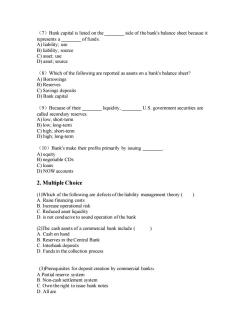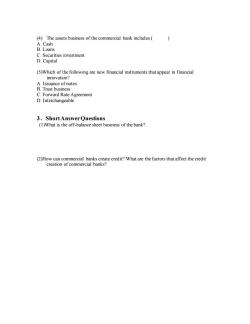同济大学:《货币金融学》课程教学资源(试卷习题)Chapter 5 Commercial Banks

Chapter 5 Commercial Banks 1.Single Choice (1)Which of the following statements are true? A)A bank's assets are its sources of funds. B)A bank's liabilities are its uses of funds. C)A bank's balance sheet shows that total assets equal total liabilities plus equity capital. D)A bank's balance sheet indicates whether or not the bank is profitable. (2)Which of the following statements are true? A)Checkable deposits are payable on demand. B)Checkable deposits do not include NOW accounts. C)Checkable deposits are the primary source of bank funds. D)Demand deposits are checkable deposits that pay interest. (3)Because checking accounts are liquid for the depositor than passbook savings,they earn interest rates. A)less;higher B)less;lower C)more;higher D)more;lower (4)Large-denomination CDs are so that like a bond they can be resold in a market before they mature. A)nonnegotiable;secondary B)nonnegotiable;primary C)negotiable;secondary D)negotiable;primary (5)Bank loans from the Federal Reserve are called and represent a of funds. A)discount loans;use B)discount loans;source C)fed funds;use D)fed funds;source (6)Bank capital is equal to minus A)total assets;total liabilities B)total liabilities;total assets C)total assets;total reserves D)total liabilities;total borrowings
Chapter 5 Commercial Banks 1.Single Choice (1) Which of the following statements are true? A) A bank's assets are its sources of funds. B) A bank's liabilities are its uses of funds. C) A bank's balance sheet shows that total assets equal total liabilities plus equity capital. D) A bank's balance sheet indicates whether or not the bank is profitable. (2)Which of the following statements are true? A) Checkable deposits are payable on demand. B) Checkable deposits do not include NOW accounts. C) Checkable deposits are the primary source of bank funds. D) Demand deposits are checkable deposits that pay interest. (3)Because checking accounts are ________ liquid for the depositor than passbook savings, they earn ________ interest rates. A) less; higher B) less; lower C) more; higher D) more; lower (4)Large-denomination CDs are ________, so that like a bond they can be resold in a ________ market before they mature. A) nonnegotiable; secondary B) nonnegotiable; primary C) negotiable; secondary D) negotiable; primary (5)Bank loans from the Federal Reserve are called ________ and represent a ________ of funds. A) discount loans; use B) discount loans; source C) fed funds; use D) fed funds; source (6)Bank capital is equal to ________ minus ________. A) total assets; total liabilities B) total liabilities; total assets C) total assets; total reserves D) total liabilities; total borrowings

(7)Bank capital is listed on the side of the bank's balance sheet because it represents a of funds. A)liability;use B)liability;source C)asset;use D)asset;source (8)Which of the following are reported as assets on a bank's balance sheet? A)Borrowings B)Reserves C)Savings deposits D)Bank capital (9)Because of their liquid ity, U.S.government securities are called secondary reserves. A)low;short-term B)low;long-term C)high;short-term D)high;long-term (10)Bank's make their profits primarily by issuing A)equity B)negotiable CDs C)loans D)NOW accounts 2.Multiple Choice (1)Which of the following are defects of the liability management theory A.Raise financing costs B.Increase operational risk C.Reduced asset liquidity D.is not conducive to sound operation of the bank (2)The cash assets of a commercial bank include A.Cash on hand B.Reserves in the Central Bank C.Interbank deposits D.Funds in the collection process (3)Prerequisites for deposit creation by commercial banks: A.Partial reserve system B.Non-cash settlement system C.Own the right to issue bank notes D.All are
(7)Bank capital is listed on the ________ side of the bank's balance sheet because it represents a ________ of funds. A) liability; use B) liability; source C) asset; use D) asset; source (8)Which of the following are reported as assets on a bank's balance sheet? A) Borrowings B) Reserves C) Savings deposits D) Bank capital (9)Because of their ________ liquidity, ________ U.S. government securities are called secondary reserves. A) low; short-term B) low; long-term C) high; short-term D) high; long-term (10)Bank's make their profits primarily by issuing ________. A) equity B) negotiable CDs C) loans D) NOW accounts 2. Multiple Choice (1)Which of the following are defects of the liability management theory ( ) A. Raise financing costs B. Increase operational risk C. Reduced asset liquidity D. is not conducive to sound operation of the bank (2)The cash assets of a commercial bank include ( ) A. Cash on hand B. Reserves in the Central Bank C. Interbank deposits D. Funds in the collection process (3)Prerequisites for deposit creation by commercial banks: A.Partial reserve system B. Non-cash settlement system C. Own the right to issue bank notes D. All are

(4)The assets business of the commercial bank includes( A.Cash B.Loans C.Securities investment D.Capital (5)Which of the following are new financial instruments that appear in financial innovation? A.Issuance ofnotes B.Trust business C.Forward Rate Agreement D.Interchangeable 3.ShortAnswer Questions (1)What is the off-balance sheet business of the bank? (2)How can commercial banks create credit?What are the factors that affect the credit creation of commercial banks?
(4) The assets business of the commercial bank includes ( ) A. Cash B. Loans C. Securities investment D. Capital (5)Which of the following are new financial instruments that appear in financial innovation? A. Issuance of notes B. Trust business C. Forward Rate Agreement D. Interchangeable 3、Short Answer Questions (1)What is the off-balance sheet business of the bank? (2)How can commercial banks create credit? What are the factors that affect the credit creation of commercial banks?
按次数下载不扣除下载券;
注册用户24小时内重复下载只扣除一次;
顺序:VIP每日次数-->可用次数-->下载券;
- 同济大学:《货币金融学》课程教学资源(试卷习题)Chapter 4 The Economics of Financial Intermediary.docx
- 同济大学:《货币金融学》课程教学资源(试卷习题)Chapter 3 Interest and Interest Rate.docx
- 同济大学:《货币金融学》课程教学资源(试卷习题)Chapter 2 Credit and Financial Instruments.docx
- 同济大学:《货币金融学》课程教学资源(试卷习题)Chapter 1 Money and Monetary System.docx
- 同济大学:《货币金融学》课程教学资源(大纲教案)教学大纲 The Economics of Money and Banking.pdf
- 吉林大学:《财政学》课程教学资源(试卷习题)远程教育考试样卷(无答案).doc
- 吉林大学:《经济法》课程电子教案(PPT教学课件,共十三章,授课对象:远程教育,授课教师:孙凤英).ppt
- 《财务管理》课程教学资源(专项报告)南宁市宾阳县生猪现代农业产业园实施方案(简版).pdf
- 《财务管理》课程教学资源(专项报告)存栏1120头商品猪养殖小区可行性研究报告(简版).pdf
- 《财务管理》课程教学资源(专项报告)存栏2000头祖代原种猪场可行性研究报告(简版).pdf
- 《财务管理》课程教学资源(专项报告)存栏3000头曾祖代原种猪场环保生态养殖综合开发项目可研报告(简版).pdf
- 《财务管理》课程教学资源(专项报告)存栏5000头基础母猪现代化生猪养殖场可行性研究报告(简版).pdf
- 《财务管理》课程教学资源(专项报告)山西灵空山国家级自然保护区2016年林业国家级自然保护区补助资金建设项目可行性研究报告(简版).pdf
- 《财务管理》课程教学资源(专项报告)森林康养度假建设项目可行性研究报告(简版).pdf
- 山西农业大学:《财务管理》课程教学资源(试卷习题)财务管理期末考试模拟题三及答案.pdf
- 山西农业大学:《财务管理》课程教学资源(试卷习题)财务管理期末考试模拟题二及答案.pdf
- 山西农业大学:《财务管理》课程教学资源(试卷习题)财务管理期末考试模拟题一及答案.pdf
- 山西农业大学:《财务管理》课程教学资源(试卷习题)第八章 利润分配管理(含答案).pdf
- 山西农业大学:《财务管理》课程教学资源(试卷习题)第七章 营运资金管理(含答案).pdf
- 山西农业大学:《财务管理》课程教学资源(试卷习题)第五章 固定资产投资(含答案).pdf
- 同济大学:《货币金融学》课程教学资源(试卷习题)Chapter 6 Central Banks.docx
- 同济大学:《货币金融学》课程教学资源(试卷习题)Chapter 7 Financial Markets.docx
- 同济大学:《货币金融学》课程教学资源(试卷习题)Chapter 8 Money Supply and Money Demand.docx
- 同济大学:《货币金融学》课程教学资源(试卷习题)Chapter 9 Money and Inflation.docx
- 同济大学:《货币金融学》课程教学资源(试卷习题)Answers for Test Sample(参考答案)Chapter 1-10.docx
- 同济大学:《货币金融学》课程电子教案(课件讲稿)Chapter 1 Introduction(负责人:郭英).pdf
- 同济大学:《货币金融学》课程电子教案(课件讲稿)Chapter 2 Money and Monetary System.pdf
- 同济大学:《货币金融学》课程电子教案(课件讲稿)Chapter 3 Credit and Financial Instrument.pdf
- 同济大学:《货币金融学》课程电子教案(课件讲稿)Chapter 4 Interest and Interest Rate.pdf
- 同济大学:《货币金融学》课程电子教案(课件讲稿)Chapter 5 Financial Institutions.pdf
- 同济大学:《货币金融学》课程电子教案(课件讲稿)Chapter 6 Commercial Banks.pdf
- 同济大学:《货币金融学》课程电子教案(课件讲稿)Chapter 7 Central Banks.pdf
- 同济大学:《货币金融学》课程电子教案(课件讲稿)Chapter 8 Financial Markets.pdf
- 同济大学:《货币金融学》课程电子教案(课件讲稿)Chapter 10 Monetary Policy.pdf
- 同济大学:《货币金融学》课程电子教案(课件讲稿)Chapter 9 Money Demand and Money Supply.pdf
- 同济大学:《货币金融学》课程电子教案(课件讲稿)Chapter 11 Inflation and Deflation.pdf
- 吉林大学:《会计学》课程电子教案(PPT课件)第一章 绪论(负责人:孙烨).ppt
- 吉林大学:《会计学》课程电子教案(PPT课件)第二章 帐户与复式记帐.ppt
- 吉林大学:《会计学》课程电子教案(PPT课件)第三章 分录与记帐.ppt
- 吉林大学:《会计学》课程电子教案(PPT课件)第四章 试算与调整.ppt
